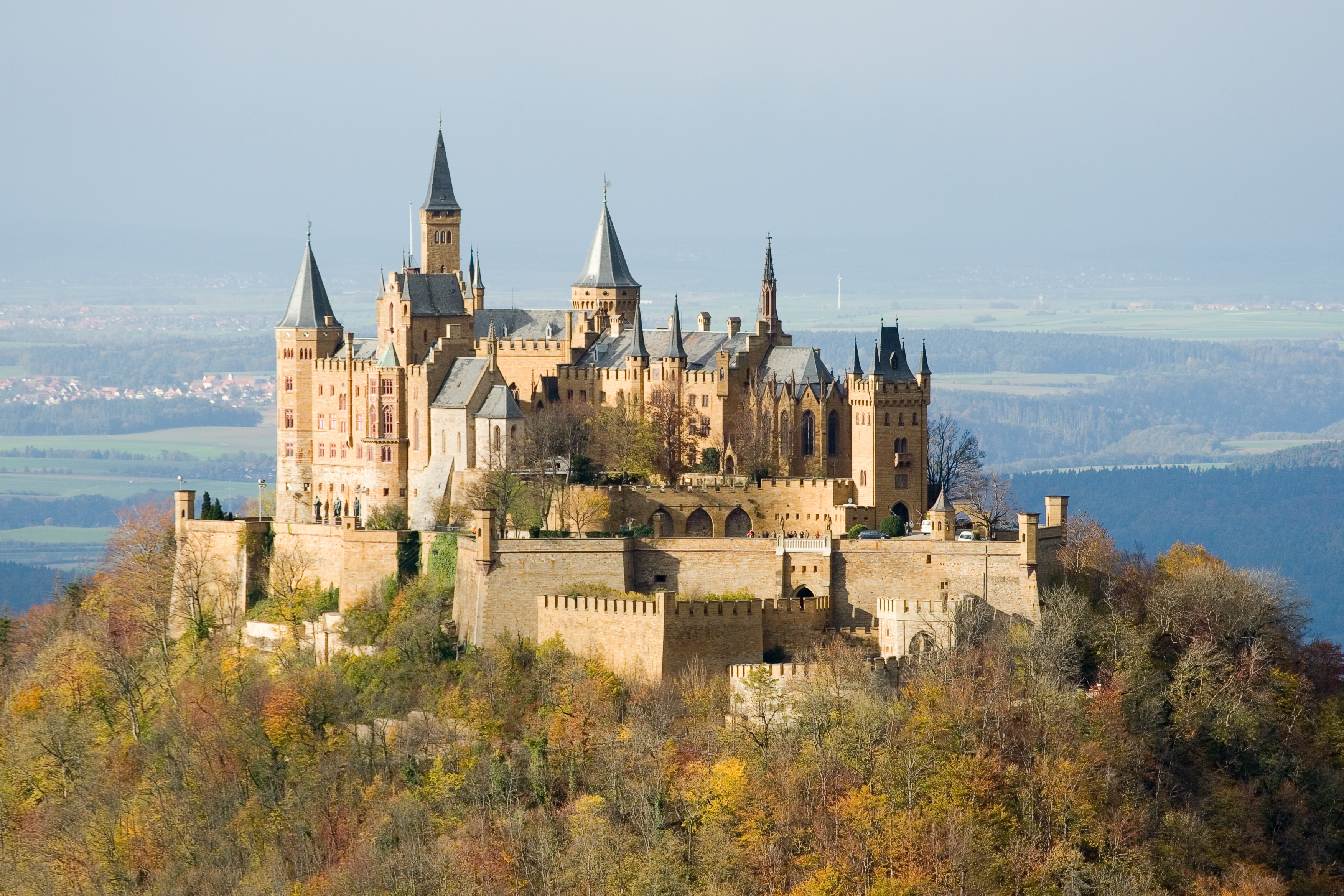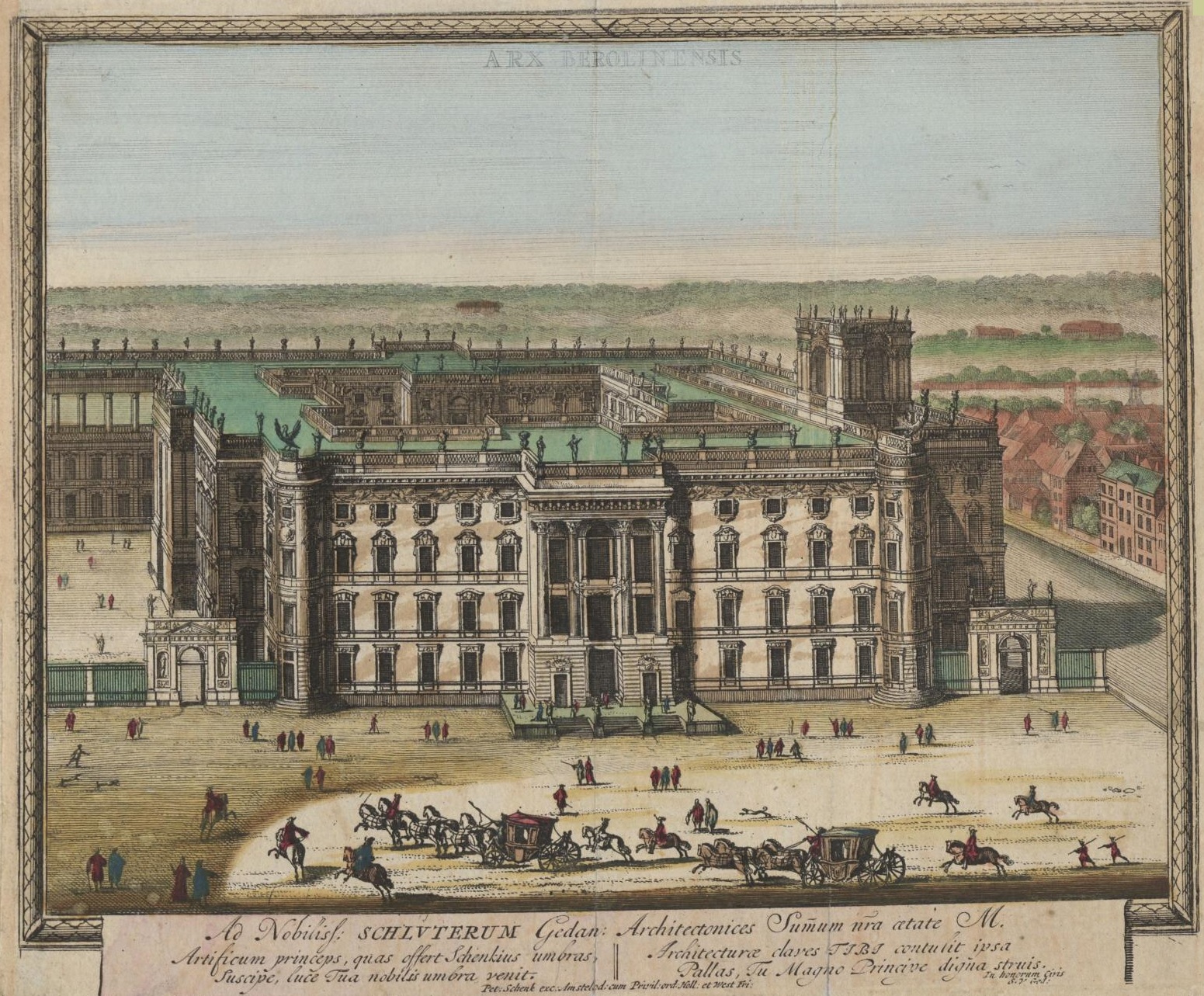|
Magdalena Of Brandenburg, Countess Of Hohenzollern
Magdalene of Brandenburg (1460 in Tangermünde – 17 June 1496 at Hohenzollern Castle) was a German noblewoman. She was a princess of Brandenburg by birth and by marriage a Duchess of Hohenzollern. Life Magdalena was the only child of Margrave Frederick III of Brandenburg-Altmark (1424–1463) from his marriage to Agnes (1436–1512), daughter of the Duke Barnim VIII of Pomerania. She married on 17 June 1482 in the Berlin City Palace to Count Eitel Friedrich II of Hohenzollern (1452–1512). This marriage formed an important connection for the House of Hohenzollern, as it strengthened the bond between the Swabian and Brandenburg branches of the house. Magdalena became the ancestress of the Hohenzollern-Hechingen and Hohenzollern-Sigmaringen lines. Magdalena died in 1496 and was buried in the collegiate church of St. James in Hechingen. A grave plate next to the high altar, probably sculpted by Peter Vischer the Elder, shows Magdalena and her husband in a traditional ... [...More Info...] [...Related Items...] OR: [Wikipedia] [Google] [Baidu] |
House Of Hohenzollern
The House of Hohenzollern (, also , german: Haus Hohenzollern, , ro, Casa de Hohenzollern) is a German royal (and from 1871 to 1918, imperial) dynasty whose members were variously princes, electors, kings and emperors of Hohenzollern, Brandenburg, Prussia, the German Empire, and Romania. The family came from the area around the town of Hechingen in Swabia during the late 11th century and took their name from Hohenzollern Castle. The first ancestors of the Hohenzollerns were mentioned in 1061. The Hohenzollern family split into two branches, the Catholic Swabian branch and the Protestant Franconian branch,''Genealogisches Handbuch des Adels, Fürstliche Häuser'' XIX. "Haus Hohenzollern". C.A. Starke Verlag, 2011, pp. 30–33. . which ruled the Burgraviate of Nuremberg and later became the Brandenburg-Prussian branch. The Swabian branch ruled the principalities of Hohenzollern-Hechingen and Hohenzollern-Sigmaringen until 1849, and also ruled Romania from 1866 to 1947. ... [...More Info...] [...Related Items...] OR: [Wikipedia] [Google] [Baidu] |
Hohenzollern-Hechingen
Hohenzollern-Hechingen was a small principality in southwestern Germany. Its rulers belonged to the Swabian branch of the Hohenzollern dynasty. History The County of Hohenzollern-Hechingen was created in 1576, upon the partition of the County of Hohenzollern, a fief of the Holy Roman Empire. When the last count of Hohenzollern, Charles I of Hohenzollern (1512–1579) died, the territory was to be divided up between his three sons: * Eitel Frederick IV of Hohenzollern-Hechingen (1545–1605) * Charles II of Hohenzollern-Sigmaringen (1547–1606) * Christopher of Hohenzollern-Haigerloch (1552–1592) Unlike the Hohenzollerns of Brandenburg and Prussia, the Hohenzollerns of southwest Germany remained Roman Catholic. The county was raised to a principality in 1623. The principality joined the Confederation of the Rhine in 1806 and was a member state of the German Confederation between 1815 and 1850. The democratic Revolution of 1848 was relatively successful in Hohenz ... [...More Info...] [...Related Items...] OR: [Wikipedia] [Google] [Baidu] |
1460 Births
146 may refer to: * 146 (number), a natural number * AD 146, a year in the 2nd century AD * 146 BC, a year in the 2nd century BC * 146 (Antrim Artillery) Corps Engineer Regiment, Royal Engineers See also * List of highways numbered 146 * {{Number disambiguation ... [...More Info...] [...Related Items...] OR: [Wikipedia] [Google] [Baidu] |
German Countesses
German(s) may refer to: * Germany (of or related to) **Germania (historical use) * Germans, citizens of Germany, people of German ancestry, or native speakers of the German language ** For citizens of Germany, see also German nationality law **Germanic peoples (Roman times) * German language **any of the Germanic languages * German cuisine, traditional foods of Germany People * German (given name) * German (surname) * Germán, a Spanish name Places * German (parish), Isle of Man * German, Albania, or Gërmej * German, Bulgaria * German, Iran * German, North Macedonia * German, New York, U.S. * Agios Germanos, Greece Other uses * German (mythology), a South Slavic mythological being * Germans (band), a Canadian rock band * "German" (song), a 2019 song by No Money Enterprise * ''The German'', a 2008 short film * "The Germans", an episode of ''Fawlty Towers'' * ''The German'', a nickname for Congolese rebel André Kisase Ngandu See also * Germanic (other) ... [...More Info...] [...Related Items...] OR: [Wikipedia] [Google] [Baidu] |
Eitel Frederick III, Count Of Hohenzollern
Eitel Friedrich III, Count of Hohenzollern (1494 – 15 January 1525 in Pavia) was Count of County of Hohenzollern from 1512 until his death. Life Eitel Friedrich was a son of Count Eitel Friedrich II (1452–1512) from his marriage to Magdalena (1460 -1496), the daughter of Margrave Friedrich of Altmark. Eitel Friedrich succeeded his father as Count of Hohenzollern in 1512. In 1515, he married Johanna of Witthem (d. 1544), the daughter of Philip, Lord of Beersel and Boutersem. Eitel Friedrich III was top councillor and great chamberlain to Emperor Maximilian I, which demonstrates that he, like his father before him, had excellent relations with the Habsburgs. He was also Imperial Archchamberlain and captain of the Lordship of Hohenberg. He died in Pavia in 1525; he may have been poisoned. He was in Pavia to serve as captain of the Landsknecht regiment. He was buried in the Basilica of San Pietro in Ciel d'Oro of Pavia. Issue His marriage Eitel Friedrich ha ... [...More Info...] [...Related Items...] OR: [Wikipedia] [Google] [Baidu] |
Rosine Of Baden
Rosine may refer to: * Rosine (given name), list of people and fictional characters with this name * ''Rosine'', a film directed by Christine Carrière awarded a César in 1996 * ''Rosine'' a song by singer Soukous and composer Aurlus Mabélé * Rosine, Kentucky, an unincorporated town in Ohio County, United States See also * Dewey Avenue–West Rosine Historic District in St. Joseph, Missouri, United States * Rosin (other) * Rosina (other) Rosina may refer to: *Rosina, Slovakia, a municipality in Slovakia * Rosina, Bulgaria, a village in Targovishte Municipality *Rosina, West Virginia *Rosina (given name), feminine given name *Rosina (surname) *Rosina (ship), list of ships with this n ... * Rose (other) {{disambiguation ... [...More Info...] [...Related Items...] OR: [Wikipedia] [Google] [Baidu] |
Peter Vischer The Elder
Peter Vischer the Elder (c. 1455January 7, 1529) was a German sculptor, the son of Hermann Vischer, and the most notable member of the Vischer Family of Nuremberg. Biography Peter was born in Nuremberg, where he also died. He became "master" in 1489, and in 1494 was summoned by Philip, Elector Palatine to Heidelberg. He soon returned, however, to Nuremberg, where he worked with the help of his five sons, Hermann, Peter, Hans, Jakob and Paul. Works * Tomb of Bishop Johannes IV., in the Breslau cathedral (1496) * Tomb of Archbishop Ernest, in Magdeburg Cathedral (1495) His chief early work. It is surrounded with statuettes of the Apostles under semi-Gothic canopies. It is purer in style than the Shrine of Saint Sebald (see next item). * Shrine of Saint Sebald located in the St. Sebaldus Church at Nuremberg (between 1508 and 1519): A tall canopied bronze structure, crowded with reliefs and statuettes in the most lavish way. The general form of the shrine is Gothic, but the de ... [...More Info...] [...Related Items...] OR: [Wikipedia] [Google] [Baidu] |
Hohenzollern-Sigmaringen
Hohenzollern-Sigmaringen was a principality in Southwestern Germany. Its rulers belonged to the senior Swabian branch of the House of Hohenzollern. The Swabian Hohenzollerns were elevated to princes in 1623. The small sovereign state with the capital city of Sigmaringen was annexed to the Kingdom of Prussia in 1850 following the abdication of its sovereign in the wake of the revolutions of 1848, then became part of the newly created Province of Hohenzollern. History The senior Swabian branch is not as well known to history, as is the junior Franconian line which became Burgraves of Nuremberg and later ruled Brandenburg and Prussia, and the German Empire. The County of Hohenzollern-Sigmaringen was created in 1576, upon the partition of the County of Hohenzollern, a fief of the Holy Roman Empire. When the last count of Hohenzollern, Karl I (1512–1579) died, the territory was divided among his three sons: * Eitel Friedrich IV of Hohenzollern-Hechingen (1545–1605) * Char ... [...More Info...] [...Related Items...] OR: [Wikipedia] [Google] [Baidu] |
Stadtschloss, Berlin
The Berlin Palace (german: Berliner Schloss), formally the Royal Palace (german: Königliches Schloss), on the Museum Island in the Mitte area of Berlin, was the main residence of the House of Hohenzollern from 1443 to 1918. Expanded by order of King Frederick I of Prussia according to plans by Andreas Schlüter from 1689 to 1713, it was thereafter considered a major work of Prussian Baroque architecture. The former royal palace was one of Berlin’s largest buildings and shaped the cityscape with its dome. Used for various government functions after the fall of the monarchy in 1918, it was damaged during the Allied bombing in World War II, and was demolished by the East German authorities in 1950. In the 1970s, it became the location of the modernist East German Palace of the Republic (the central government building of East Germany). After German reunification and several years of debate and discussion, particularly regarding the fraught historical legacy of both buildi ... [...More Info...] [...Related Items...] OR: [Wikipedia] [Google] [Baidu] |
Frederick Of Altmark
Frederick III of Brandenburg, nicknamed the Fat, also the Younger (born: ; died: 6 October 1463 in Tangermünde) was Margrave of Brandenburg and Lord of the Altmark. Life Frederick was the youngest son of the Elector Frederick I of Brandenburg (1371–1440) from his marriage to Elizabeth (1383–1442 ), daughter of the Duke Frederick of Bavaria-Landshut. His father's testament, stipulated that Frederick should rule the Margraviate of Brandenburg jointly with his older brother Frederick Irontooth, who also acted as his guardian from 1440 onwards, until at least 1456. Frederick III, however, began urging for more independence in 1445. He was supported by his brothers John and Albert Achilles. In 1447, Frederick received his own territory, consisting of the Altmark and Prignitz, under the sovereignty of Electoral Brandenburg. He fostered the influx of Jews into his territory, after his brother had driven them out of his margraviate in 1446. Frederick III resided in Tangerm� ... [...More Info...] [...Related Items...] OR: [Wikipedia] [Google] [Baidu] |
Barnim VIII, Duke Of Pomerania
Barnim VIII, Duke of Pomerania (between 1405 and 1407 – between 15 and 19 December 1451) at www.ruegenwalde.com' was Duke of –– Barth. Barnim VIII was the son of Duke Wartislaw VIII of Pomerania-Wolgast. After his father's death in 1415 his widow, Agnes of Saxe-Lauenburg, initially held the guardianship of her sons Barnim VIII and Swantibor IV, and as well as the sons of h ... [...More Info...] [...Related Items...] OR: [Wikipedia] [Google] [Baidu] |
Hohenzollern
The House of Hohenzollern (, also , german: Haus Hohenzollern, , ro, Casa de Hohenzollern) is a German royal (and from 1871 to 1918, imperial) dynasty whose members were variously princes, electors, kings and emperors of Hohenzollern, Brandenburg, Prussia, the German Empire, and Romania. The family came from the area around the town of Hechingen in Swabia during the late 11th century and took their name from Hohenzollern Castle. The first ancestors of the Hohenzollerns were mentioned in 1061. The Hohenzollern family split into two branches, the Catholic Swabian branch and the Protestant Franconian branch,''Genealogisches Handbuch des Adels, Fürstliche Häuser'' XIX. "Haus Hohenzollern". C.A. Starke Verlag, 2011, pp. 30–33. . which ruled the Burgraviate of Nuremberg and later became the Brandenburg-Prussian branch. The Swabian branch ruled the principalities of Hohenzollern-Hechingen and Hohenzollern-Sigmaringen until 1849, and also ruled Romania from 1866 to 1947. Membe ... [...More Info...] [...Related Items...] OR: [Wikipedia] [Google] [Baidu] |




